Jee-Hwan Ryu
Self-Wearing Adaptive Garments via Soft Robotic Unfurling
Jul 09, 2025Abstract:Robotic dressing assistance has the potential to improve the quality of life for individuals with limited mobility. Existing solutions predominantly rely on rigid robotic manipulators, which have challenges in handling deformable garments and ensuring safe physical interaction with the human body. Prior robotic dressing methods require excessive operation times, complex control strategies, and constrained user postures, limiting their practicality and adaptability. This paper proposes a novel soft robotic dressing system, the Self-Wearing Adaptive Garment (SWAG), which uses an unfurling and growth mechanism to facilitate autonomous dressing. Unlike traditional approaches,the SWAG conforms to the human body through an unfurling based deployment method, eliminating skin-garment friction and enabling a safer and more efficient dressing process. We present the working principles of the SWAG, introduce its design and fabrication, and demonstrate its performance in dressing assistance. The proposed system demonstrates effective garment application across various garment configurations, presenting a promising alternative to conventional robotic dressing assistance.
SIO-Mapper: A Framework for Lane-Level HD Map Construction Using Satellite Images and OpenStreetMap with No On-Site Visits
Apr 14, 2025Abstract:High-definition (HD) maps, particularly those containing lane-level information regarded as ground truth, are crucial for vehicle localization research. Traditionally, constructing HD maps requires highly accurate sensor measurements collection from the target area, followed by manual annotation to assign semantic information. Consequently, HD maps are limited in terms of geographic coverage. To tackle this problem, in this paper, we propose SIO-Mapper, a novel lane-level HD map construction framework that constructs city-scale maps without physical site visits by utilizing satellite images and OpenStreetmap data. One of the key contributions of SIO-Mapper is its ability to extract lane information more accurately by introducing SIO-Net, a novel deep learning network that integrates features from satellite image and OpenStreetmap using both Transformer-based and convolution-based encoders. Furthermore, to overcome challenges in merging lanes over large areas, we introduce a novel lane integration methodology that combines cluster-based and graph-based approaches. This algorithm ensures the seamless aggregation of lane segments with high accuracy and coverage, even in complex road environments. We validated SIO-Mapper on the Naver Labs Open Dataset and NuScenes dataset, demonstrating better performance in various environments including Korea, the United States, and Singapore compared to the state-of-the-art lane-level HD mapconstruction methods.
Teaching Robots to Handle Nuclear Waste: A Teleoperation-Based Learning Approach<
Apr 02, 2025Abstract:This paper presents a Learning from Teleoperation (LfT) framework that integrates human expertise with robotic precision to enable robots to autonomously perform skills learned from human operators. The proposed framework addresses challenges in nuclear waste handling tasks, which often involve repetitive and meticulous manipulation operations. By capturing operator movements and manipulation forces during teleoperation, the framework utilizes this data to train machine learning models capable of replicating and generalizing human skills. We validate the effectiveness of the LfT framework through its application to a power plug insertion task, selected as a representative scenario that is repetitive yet requires precise trajectory and force control. Experimental results highlight significant improvements in task efficiency, while reducing reliance on continuous operator involvement.
Development of a Collaborative Robotic Arm-based Bimanual Haptic Display
Nov 11, 2024



Abstract:This paper presents a bimanual haptic display based on collaborative robot arms. We address the limitations of existing robot arm-based haptic displays by optimizing the setup configuration and implementing inertia/friction compensation techniques. The optimized setup configuration maximizes workspace coverage, dexterity, and haptic feedback capability while ensuring collision safety. Inertia/friction compensation significantly improve transparency and reduce user fatigue, leading to a more seamless and transparent interaction. The effectiveness of our system is demonstrated in various applications, including bimanual bilateral teleoperation in both real and simulated environments. This research contributes to the advancement of haptic technology by presenting a practical and effective solution for creating high-performance bimanual haptic displays using collaborative robot arms.
External Steering of Vine Robots via Magnetic Actuation
Sep 02, 2024Abstract:This paper explores the concept of external magnetic control for vine robots to enable their high curvature steering and navigation for use in endoluminal applications. Vine robots, inspired by natural growth and locomotion strategies, present unique shape adaptation capabilities that allow passive deformation around obstacles. However, without additional steering mechanisms, they lack the ability to actively select the desired direction of growth. The principles of magnetically steered growing robots are discussed, and experimental results showcase the effectiveness of the proposed magnetic actuation approach. We present a 25 mm diameter vine robot with integrated magnetic tip capsule, including 6 Degrees of Freedom (DOF) localization and camera and demonstrate a minimum bending radius of 3.85 cm with an internal pressure of 30 kPa. Furthermore, we evaluate the robot's ability to form tight curvature through complex navigation tasks, with magnetic actuation allowing for extended free-space navigation without buckling. The suspension of the magnetic tip was also validated using the 6 DOF localization system to ensure that the shear-free nature of vine robots was preserved. Additionally, by exploiting the magnetic wrench at the tip, we showcase preliminary results of vine retraction. The findings contribute to the development of controllable vine robots for endoluminal applications, providing high tip force and shear-free navigation.
Ambiguity-Aware Multi-Object Pose Optimization for Visually-Assisted Robot Manipulation
Nov 02, 2022Abstract:6D object pose estimation aims to infer the relative pose between the object and the camera using a single image or multiple images. Most works have focused on predicting the object pose without associated uncertainty under occlusion and structural ambiguity (symmetricity). However, these works demand prior information about shape attributes, and this condition is hardly satisfied in reality; even asymmetric objects may be symmetric under the viewpoint change. In addition, acquiring and fusing diverse sensor data is challenging when extending them to robotics applications. Tackling these limitations, we present an ambiguity-aware 6D object pose estimation network, PrimA6D++, as a generic uncertainty prediction method. The major challenges in pose estimation, such as occlusion and symmetry, can be handled in a generic manner based on the measured ambiguity of the prediction. Specifically, we devise a network to reconstruct the three rotation axis primitive images of a target object and predict the underlying uncertainty along each primitive axis. Leveraging the estimated uncertainty, we then optimize multi-object poses using visual measurements and camera poses by treating it as an object SLAM problem. The proposed method shows a significant performance improvement in T-LESS and YCB-Video datasets. We further demonstrate real-time scene recognition capability for visually-assisted robot manipulation. Our code and supplementary materials are available at https://github.com/rpmsnu/PrimA6D.
OpenStreetMap-based LiDAR Global Localization in Urban Environment without a Prior LiDAR Map
Feb 15, 2022



Abstract:Using publicly accessible maps, we propose a novel vehicle localization method that can be applied without using prior light detection and ranging (LiDAR) maps. Our method generates OSM descriptors by calculating the distances to buildings from a location in OpenStreetMap at a regular angle, and LiDAR descriptors by calculating the shortest distances to building points from the current location at a regular angle. Comparing the OSM descriptors and LiDAR descriptors yields a highly accurate vehicle localization result. Compared to methods that use prior LiDAR maps, our method presents two main advantages: (1) vehicle localization is not limited to only places with previously acquired LiDAR maps, and (2) our method is comparable to LiDAR map-based methods, and especially outperforms the other methods with respect to the top one candidate at KITTI dataset sequence 00.
A Tip Mount for Carrying Payloads using Soft Growing Robots
Dec 17, 2019

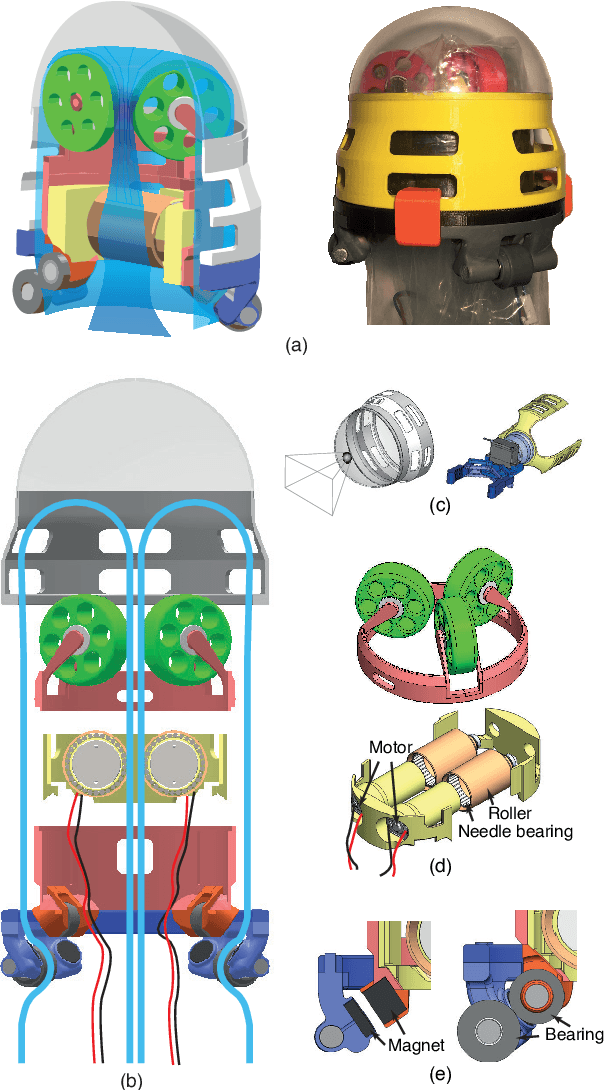
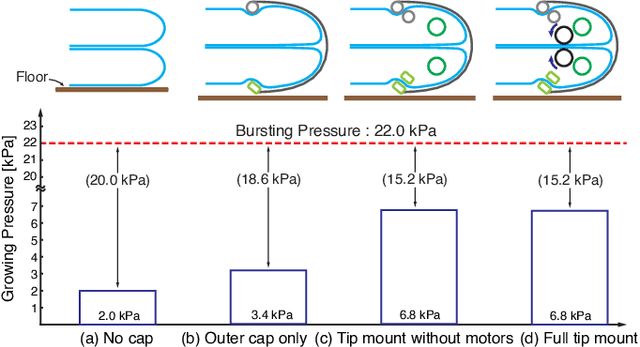
Abstract:Pneumatically operated soft growing robots that lengthen through tip eversion can be used for inspection and manipulation tasks in confined spaces such as caves, animal habitats, or disaster environments. Because new material is continually emitted from the robot tip, it is challenging to mount sensors, grippers, or other useful payloads at the tip of the robot. Here, we present a tip mount for soft growing robots that can be reliably used and remain attached to the tip during growing, retraction, and steering, while carrying a variety of payloads, including active devices. Our tip mount enables two new soft growing robot capabilities: retracting without buckling while carrying a payload at the tip, and exerting a significant tensile load on the environment during inversion. In this paper, we review previous research on soft growing robot tip mounts, and we discuss the important features of a successful tip mount. We present the design of our tip mount and results for the minimum pressure to grow and the maximum payload in tension. We also demonstrate a soft growing robot equipped with our tip mount retrieving an object and delivering it to a different location.
Vine Robots: Design, Teleoperation, and Deployment for Navigation and Exploration
Feb 28, 2019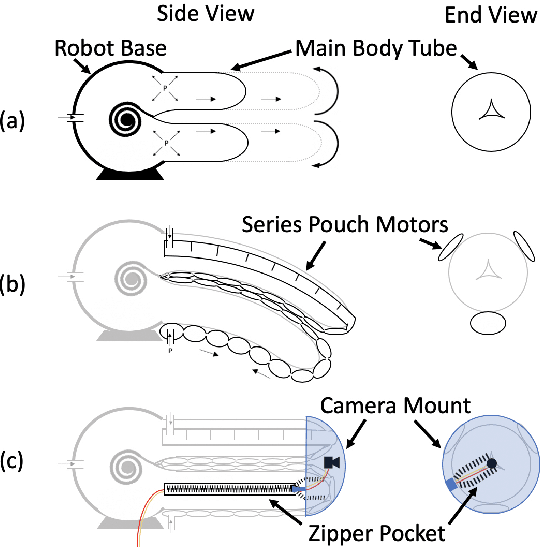
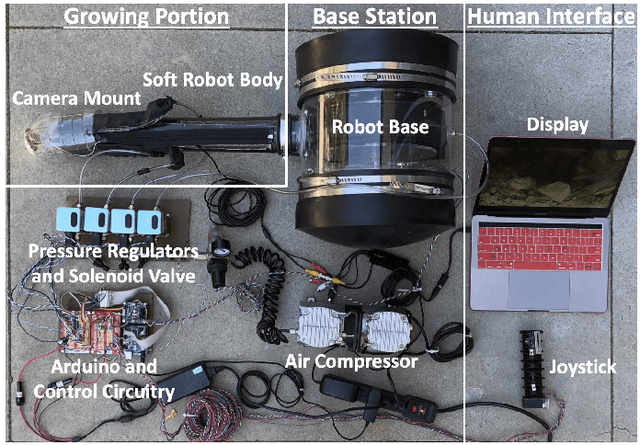
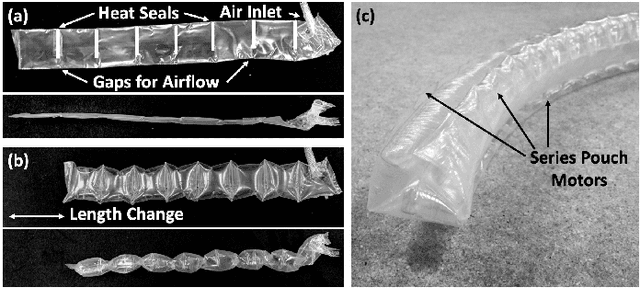
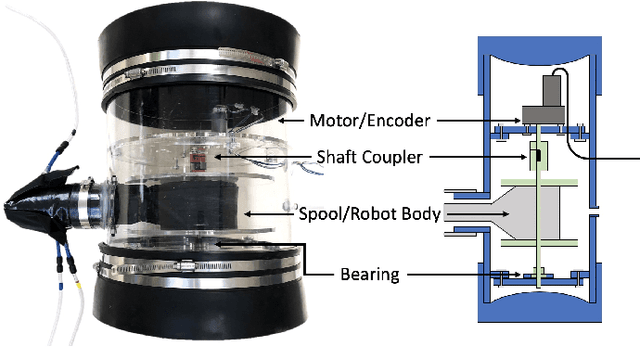
Abstract:A new class of robots has recently been explored, characterized by tip extension, significant length change, and directional control. Here, we call this class of robots "vine robots," due to their similar behavior to plants with the growth habit of trailing. Due to their growth-based movement, vine robots are well suited for navigation and exploration in cluttered environments, but until now, they have not been deployed outside the lab. Portability of these robots and steerability at length scales relevant for navigation are key to field applications. In addition, intuitive human-in-the-loop teleoperation enables movement in unknown and dynamic environments. We present a vine robot system that is teleoperated using a custom designed flexible joystick and camera system, long enough for use in navigation tasks, and portable for use in the field. We report on deployment of this system in two scenarios: a soft robot navigation competition and exploration of an archaeological site. The competition course required movement over uneven terrain, past unstable obstacles, and through a small aperture. The archaeological site required movement over rocks and through horizontal and vertical turns. The robot tip successfully moved past the obstacles and through the tunnels, demonstrating the capability of vine robots to achieve real-world navigation and exploration tasks.
 Add to Chrome
Add to Chrome Add to Firefox
Add to Firefox Add to Edge
Add to Edge